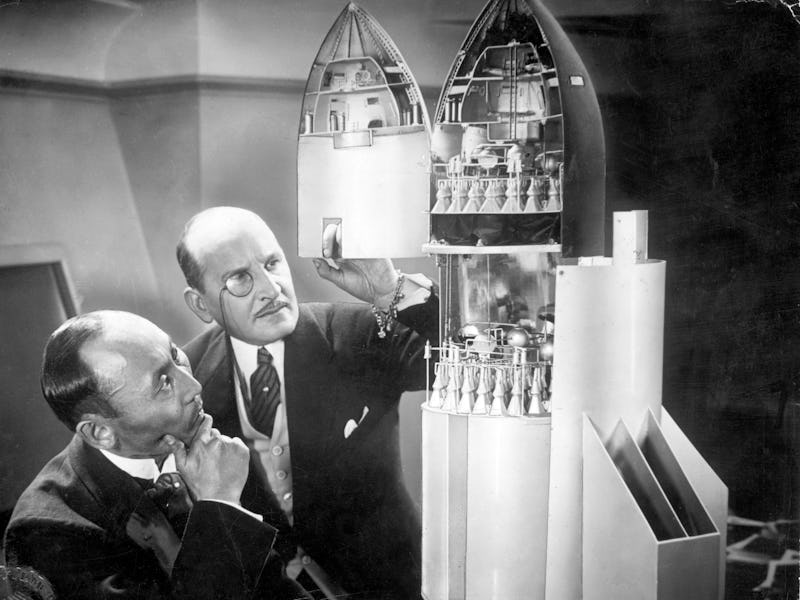Before Man Walked on the Moon, Fritz Lang Depicted Space Travel as a Reality
That’s one small step for man, one giant leap for cinema.

No one could accuse Fritz Lang of neglecting his homework while shooting his final movie of the cinematic decade he’d helped to define. To heighten the authenticity of silent film Woman in the Moon (aka Frau im Mond), the auteur roped in science writer and future cryptozoologist Willy Ley as consultant, and tasked Hermann Oberth, the real-life rocket scientist who’d later apply his technical knowhow to the Nazis’ vengeance weapon V-2, with creating the awe-inspiring ship that propelled its intrepid heroes into space.
Oberth’s work was so convincing, in fact, that the 1929 classic — which celebrates its 95th anniversary this month — was banned during World War II, his rocket design said to be a little close for comfort to the hugely secretive real thing. That’s not the only example of Woman in the Moon’s uncanny ability to predict the future of space travel, and the future of space travel in Hollywood films, either.
The countdown to zero that kickstarts any spaceship launch? Well, that stems from the inter-titles which ratchet up the tension as the Friede rocket is about to boldly go where no rocket has been before. Lang and his team of experts also foreshadowed the use of multistage orbital ships and zero gravity foot straps, showed the effects of G-forces, and essentially invented the intergalactic sacrifice trope that’s been adopted by everything from Silent Running to Sunshine.
Watch the first half of its epic 169-minute running time, though, and you’d struggle to recognize The Woman in the Moon as a science-fiction film at all. Indeed, it takes more than an hour to first catch sight of the imposing Friede and nearly another before the motley crew of astronauts, crooks and stowaways arrive on the moon. Instead, Lang and his screenwriter wife Thea von Harbou initially seem more interested with navigating the world of industrial espionage than their lunar destination.
Its story, based on von Harbou’s novel The Rocket to the Moon, begins with Helius (Willy Fritsch, essentially pre-war Germany’s answer to George Clooney) visiting Professor Manfeldt (Klaus Pohl), a “mad scientist” literally laughed out the room while presenting his theory on the moon’s goldmine resources.
Helius, however, believes there really is gold in them there moon crates. Unfortunately, so does a villainous business group who first sends numerous henchmen to steal Manfeldt’s research before sending spy Walter Turner (Fritz Rasp, pre-war Germany’s answer to Christoph Waltz) to offer the mustache-twirling ultimatum: allow him to join the lunar mission or both their findings and their spaceship will go up in smoke.
Willy Fritsch’ Helius proving spacewear can also be cozy.
Unsurprisingly, Helius opts for the former, adding to a motley crew which also includes the newly-engaged assistants Hans Windegger (Gustav von Wangenheim) and Friede (Gerda Maurus), Manfeldt’s pet mouse Josephine and Gustav (Gustl Gstettenbaur), a 12-year-old sci-fi obsessive who’s somehow managed to sneak on board.
Even when they’re finally up in the air, Lang can’t help but focus the drama elsewhere, namely the love triangle that develops when Helius, in an act which would get him frogmarched to HR these days, declares he’s smitten with Friede (the assistant, not her namesake rocket). The Woman in the Moon has deservedly been hailed as a major influence on science-fiction cinema. Yet long before Titanic, Armageddon et al, it also recognized the big screen spectacle was more likely to strike box office gold with an element of romance, too.
Of course, those who descended upon Berlin’s UFA-Palast am Zoo cinema for its no-expense-spared premiere — including a certain Albert Einstein — were no doubt more excited about abstract animator Oskar Fischinger’s state-of-the-art special effects than any soapy melodrama. Even the man who discovered the theory of relativity would surely have been left awestruck by the imposing Kubrick-esque reveal of the Friede along with the scenes of simulated weightlessness and (for the time, anyway) seamless blend of the miniature and full-sized.
Gerda Maurus’ Friede trying her best to pass off a giant sandpit as the Moon.
Admittedly, the decision to stage the moon scenes in what looks like a giant sandpit are unlikely to have possessed the same wow factor. Even so, it’s here where the human interest starts to match the technical displays as poor Manfeldt falls down a crevasse, the wicked Turner is fatally shot during a botched hijack attempt and the remainder of the crew learn there’s not enough oxygen to return them all back to Earth.
As you’d expect, it’s the dashing leading man who comes to the rescue. Helius’ remarkably selfless offer to sacrifice himself in place of the wimpy Windegger initially suggests The Woman in the Moon is going to end on a desperately bleak note. However, Friede’s last-minute decision to keep him company — leaving her now ex-boyfriend, Gustav, and presumably the mouse to journey home — ensures Helius’ time left, no matter how limited, won’t be so lonely.
“The First Scientific Science Fiction Film,” claims the title of a documentary included on a lovingly restored edition released in 2014. Indeed, Georges Méliès’ iconic A Trip to the Moon may have been the first film to send humans into space. But The Woman in the Moon was the first to make it look humanly possible.